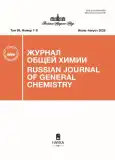Том 95, № 7–8 (2025)
Articles
Synthesis and Structure of Diethyl 2-[(Aryl)-(Morpholino/Piperidin-1-Yl)Methyl]Malonates
Аннотация
A three-component reaction of diethyl malonate with aromatic aldehyde, morpholine or piperidine during boiling in ethanol for 4 h produced diethyl 2-[(aryl)(morpholino/piperidin-1-yl)methyl]malonates. Structure of the compounds was determined by 1H, 13C NMR spectroscopy and single crystal X-ray diffraction analysis.
 240-244
240-244


Synthesis and Biological Activity of 1-Hydroxyethyl- and 1-(4-Hydroxyphenyl)-5-Aryl-4-Aroyl-3-Pyrrolin-2-Ones
Аннотация
New 1-(2-hydroxyethyl)- and 1-(4-hydroxyphenyl)-5-aryl-4-aroyl-3-hydroxy-3-pyrroline-2-ones were synthesized by the reaction of methyl esters of aroylpyruvic acids, aromatic aldehydes and ethanolamine (p-aminophenol). The antimicrobial and antinociceptive activity of the obtained compounds was studied.
 245-255
245-255


Synthesis of 1,3-Dimethylpyrimido[4′,5′:4,5]pyrrolo[1,2-b]-pyridazine-2,4(1H,3H)-diones and their 8,9-dihydro derivatives
Аннотация
Simple and effective methods were proposed for the synthesis of previously undescribed substituted pyrimido[4′,5′:4,5]pyrrolo[1,2-b]pyridazine-2,4(1H,3H)-diones and their 8,9-dihydro derivatives. Structure of the prepared compounds was studied using IR, NMR, UV spectroscopy, quantum chemical calculations and single crystal X-ray diffraction analysis.
 256-268
256-268


Thiocyanate derivatives of isobornyl phenols: synthesis and antioxidant activity
Аннотация
The synthesis of new original molecules of isobornyl phenols containing a thiocyanate group was reported. It was found that the selectivity of the nucleophilic substitution reaction is significantly influenced by such structural factors as the nature of the halide and the length of the aliphatic linker. In the case of 2,6-diisobornyl-4-bromomethylphenol, the thiocyanate was obtained at 0°C. For isobornylphenols with a propyl linker, thiocyanates were synthesized by boiling in the appropriate solvent. The obtained thiocyanate derivatives of isobornyl phenols can be considered as promising inhibitors of oxidative processes due to several reaction centers in their structure.
 269-279
269-279


Preorganized Amide Ligands Based on Resorcincalix[4]arene Platform
Аннотация
By exhaustive functionalization of rccc-tetra-C-phenethylresorcincalix[4]arene, new modified derivatives containing 8 terminal amide fragments and differing in components and size of spacers connecting the macrocyclic core with them, as well as the nature of amide groups, were synthesized. Using UV spectroscopy, acceptor properties of amide resorcinarenes towards metal cations under heterogeneous and homogeneous conditions were studied. The effect of macrocyclic core preorganization of ligand on its ability to form complex with metal cations was demonstrated.
 280-297
280-297


Synthesis and Evaluation of Antibacterial Activity of Cyclopropylphosphonates
Аннотация
Phosphonyl-substituted cyclopropanes were obtained by the reaction of O,O-diethyl (1,2-dibromoethyl)phosphonate with CH-acids, in particular, acetylacetone, acetoacetic and malonic esters, ethyl ester and amide of cyanoacetic acid, and benzyl cyanide, in the presence of a base in acetonitrile at room temperature. Antibacterial activity of the starting phosphonate and its derivatives was studied.
 298-304
298-304


Quantum-chemical study of the reaction of urea with ethylene glycol under zinc lactate catalysis
Аннотация
The reaction of urea with ethylene glycol to form ethylene carbonate catalyzed by zinc lactate was studied by the quantum-chemical density functional method B3LYP. The interaction proceeds in two stages. In the first stage, 2-hydroxyethylcarbamate is formed, which is transformed to ethylene carbonate and ammonia in the second stage. The stage limiting the reaction rate is the first stage. Four independent routes for the formation of 2-hydroxyethylcarbamate were revealed. Both monomeric and dimeric glycol molecules take part in its formation. The routes involving dimeric glycol molecules are kinetically and thermodynamically more favorable. In the zinc lactate-catalyzed transformation of 2-hydroxyethylcarbamate into ethylene carbonate, ethylene glycol acts as an effective co-catalyst. This stage is essentially reversible. The use of super stoichiometric amounts of ethylene glycol, the use of elevated temperatures, and the removal of ammonia from the reaction medium are factors that allow the successful production of ethylene carbonate by urea glycolysis under zinc lactate catalysis.
 305-318
305-318


A New Approach to the Synthesis of Nano-Sized Barium Carbonate Powders
Аннотация
A new approach to the synthesis of highly dispersed barium carbonate with specified characteristics (bulk density from 0.015 g/cm3, particle size in the range of 13–142 nm, isometric habit) was developed. It consists in sequential heat treatment up to 1100℃ of a concentrated aqueous-carbohydrate solution of Ba(NO3)2 and D-glucose. The processes of barium carbonate phase formation in the temperature range used (350–1100°C) were studied. The main stages of BaCO3 synthesis were characterized using physicochemical methods (IR spectroscopy, X-ray phase analysis, transmission electron microscopy, scanning electron microscopy), as well as chemical analysis.
 319-328
319-328


Synthesis of nanostructured aluminosilicates with different SiO2/Al2O3 ratio: analysis of composition, morphology, IR, and NMR spectra
Аннотация
The paper presents data on synthesis of nanostructured aluminosilicates (zeolites) of sodium and potassium forms with molar SiO2/Al2O3 ratio from 2 to 10 from aqueous solutions at temperature not exceeding 95°C. The results of investigations of elemental composition, morphology of nanoparticles, specific surface area of the obtained X-ray amorphous aluminosilicates, infrared spectra and nuclear magnetic resonance spectra (IR and NMR spectra) were obtained and analyzed.
 329-342
329-342


Modification of surface nanothin layers and electrochemical behavior of carbon steel in aqueous media containing nickel complex of nitrilotrismethylenephosphonic acid
Аннотация
The effect of the chelate complex compound Na4[NiN(CH2PO3)3]‧11H2O on the composition, surface concentration profile and corrosion-electrochemical behavior of the 20 steel in a borate buffer solution at pH = 7.4 and natural aeration was studied using the potentiodynamic method, X-ray photoelectron spectroscopy and scanning electron microscopy of the surface with microanalysis. The studied compound is a corrosion inhibitor; the best protective effect achieved at a concentration of 0.5 mmol/dm3. The mechanism of the inhibitory action of this inhibitor is discussed. Slowing down the anodic dissolution of iron is due to the formation of a nickel-doped layer of Fen–xNixOm oxides with a thickness of 10–20 nm on the steel surface. The mechanism of action of the studied corrosion inhibitor differs sharply from the mechanism of action of the previously studied inhibitors Na4[CuN(CH2PO3)3]‧13H2O and Na4[ZnN(CH2PO3)3]‧13H2O.
 343-354
343-354











